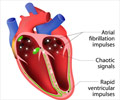HOUSTON – (June 17, 2009) – An overactive enzyme is behind a leaky calcium channel that plays a role in the development of atrial fibrillation, which is the most common cardiac arrhythmia
The leaky calcium channel that plays a role in the development of atrial fibrillation is actually caused by an overactive enzyme. Atrial fibrillation is one of the most common cardiac arrhythmia that is responsible for a third of all strokes. Researchers at Baylor College of Medicine have, however, found that the enzyme doesn't act alone.
The findings can be found online in the current edition of the Journal of Clinical Investigation."When the heart pumps properly, the muscle contractions are regulated by waves of calcium. When the heart relaxes, the calcium is stored; when the heart contracts, it is released," said Dr Xander Wehrens, assistant professor of molecular physiology and biophysics, and cardiology at BCM. "In atrial fibrillation, the calcium is released too early. As it leaks out, the heart beats too fast and irregularly."
Researchers knew that an enzyme called calmodulin kinase II is overactive in several heart diseases and believed it played a role in the leaky channels – a tiny pore that controls release of calciu through the cell's membrane. In the current study, Wehrens and colleagues were able to show in mouse models that if this enzyme is inhibited, calcium channels normalize and atrial fibrillation is prevented.
To determine if the calcium leak alone was enough to set off atrial fibrillation, researchers bred a mouse with a specific genetic mutation in the calcium channel, making it prone to leaks.
"The mice were fine. They did not develop atrial fibrillation despite the leak," Wehrens said. "There had to be another factor that contributed to arrhythmias."
Wehrens said they discovered that a sudden increase in heart rate is a very specific activator of calmodulin kinase II. The research team found that mice with the mutation were more prone to atrial fibrillation after their heart rate was sped up, activating the enzyme. Mice that lacked the mutation did not suffer from arrhythmias despite having the enzyme activated. From that they surmised that the enzyme alone did not lead to atrial fibrillation.
Advertisement
"It's a synergy. The models had to have a preexisting problem on top of overactive calmodulin kinase II," Wehrens said. "If you don't have the mutation and the enzyme, but only one or the other, then you don't develop the arrhythmia."
Advertisement
"More trials are needed, but this is a promising way to target one regulatory event that contributes to atrial fibrillation," Wehrens said. "These findings could lead to new drug therapies for arrhythmias and better patient care."
Source-Eurekalert
TAN














